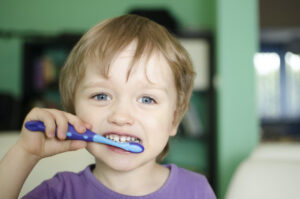
How do you take care of your baby’s teeth?
Babies are bundles of joy, and being a parent is blissful. The hard work and sleepless nights make it all worth it when you see your baby smile and laugh. But how do you take care of your baby’s teeth? Baby teeth might be tiny, but they play a vital role in your child’s development.
Typically, a baby’s first tooth develops after six months. Then, you’ll see one tooth after another pop out until the entire set of baby teeth appears. By your child’s third birthday, you can expect their adorable gummy smile to turn into two rows of their teeth, which act as a placeholder for the adult or permanent teeth.
If your child doesn’t develop a healthy set of baby teeth, they could face problems eating, smiling, or speaking. For this reason, cleaning your baby’s teeth and keeping them healthy is vital. Here is how to brush your baby’s teeth.
How to Care for Your Baby’s Gums
Every new parent wants to know when to start brushing and what’s the best way to brush their baby’s teeth. Caring for your baby’s teeth should begin when the first tooth pops into your child’s mouth. Before that, you can use a soft, moistened washcloth or gauze to take care of your baby’s gum.
You can use this washcloth to gently wipe down your baby’s gums at least twice daily, after feeding your child and before they go to sleep.
Caring for your baby’s gums helps keep their mouth free from bacteria and prevents them from clinging to the gums. Moreover, cleaning the gums stops plaque from building up and saves future infant teeth from any damage.
Teeth Brushing Tips for Babies
The first step is to choose the right toothbrush when the first tooth emerges. Choose a soft toothbrush with a small head and large handle. Start by soaking the toothbrush in warm water for a few minutes before brushing them to soften the bristles even more. After more teeth appear in the oral cavity, you can start using a rice-grain-sized amount of toothpaste, increasing to a pea-sized amount by the child’s third birthday.
Choose a fun toothpaste that tastes good to your children to promote them taking care of their dental health. We also suggest paying attention to the recommended age group on the toothpaste. Also, when brushing, ensure that you focus more on the molar region (the flat teeth near the rear of the mouth) to prevent cavities. Besides this, the basics of teeth brushing apply.
As you know, it’s vital to brush your teeth twice a day, spend at least two minutes brushing, and replace the toothbrush every season. You can brush your child’s teeth until they are old enough to hold their toothbrush.
How to Floss Your Baby’s Teeth
The flossing stage can begin once two adjacent teeth develop in the child’s oral cavity. Sugary and acidic can lead to irresistible damage to baby teeth if they drink them in excess.
Encourage Taking Care of Dental Health Early
The earlier you take care of your dental health, the better. Show your child that brushing their teeth doesn’t have to be a chore, but it’s, in fact, fun. Showing your child how to properly care for their teeth and gums gives you time to bond with them. However, it also gives them the tools to have a healthy and vibrant smile for a lifetime.
From two to eighty-two, Catonsville Dental Care serves all patients, whether they’re looking into routine dental cleanings, Invisalign, or something as complex as a root canal. Contact us today if you’re looking for a new dental home for you or your family.
Catonsville Dental Care is The Best Choice for Your Dental Health
Catonsville Dental Care offers a wide variety of services when it comes to oral health. We have the experience and understanding to diagnose and treat any problem you have as quickly and painlessly as possible. With four dentists available at our office and a commitment to comfort, safety, and relaxation, you can’t find a better provider for your health. We look forward to helping you keep your smile perfect all year long and talking with you about your needs. To schedule an appointment or consultation, visit us online or give us a call at 410-747-1115. For more tips and tricks, follow us on Facebook, Flickr, Twitter, and YouTube.
